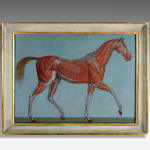Pair of Anatomical Studies of a Horse
ITALY, Painted in Milan in 1845
Both indistinctly signed; one on the reverse of the canvas, the other on the stretcher, both inscribed and dated: ‘Milano, 1845’.
72.5 x 97 cm
Further images
-
(View a larger image of thumbnail 1
)

-
(View a larger image of thumbnail 2
)

-
(View a larger image of thumbnail 3
)

-
(View a larger image of thumbnail 4
)

-
(View a larger image of thumbnail 5
)

-
(View a larger image of thumbnail 6
)

-
(View a larger image of thumbnail 7
)

-
(View a larger image of thumbnail 8
)

Provenance
Private Collection, Switzerland.Depicting the horse from a side view and showing the skeleton in the first painting; and the musculature in the second.
These highly unusual works bear little relation with the mainstream artistic movement in Milan in the 1840s. Apparently the work of a little known artist they have a unique atmosphere created by the unusual subject matter and the restrained palette. The artist may well have been inspired by George Stubbs’ celebrated publication ‘The Anatomy of the Horse‘, which was first published in 1766. Stubbs studied anatomy, and his pictures of horses are among the most accurate ever painted. His work was based on numerous meticulous dissections, a practice which was controversial at the time. Stubbs depicts the horse in three positions – side, front, and back – first presented showing the skeleton alone in each position; then producing five studies showing layers of muscles, fascias, ligaments, nerves, arteries, veins, glands, and cartilages. Stubbs’ depictions of horses are notable for their nobility and extreme anatomical precision.








